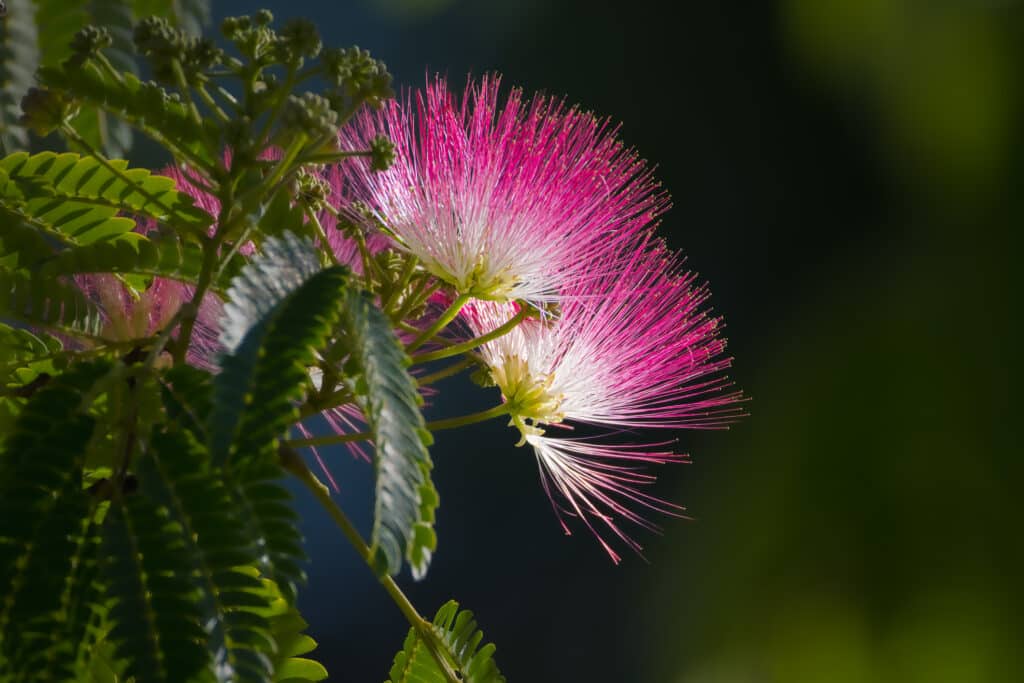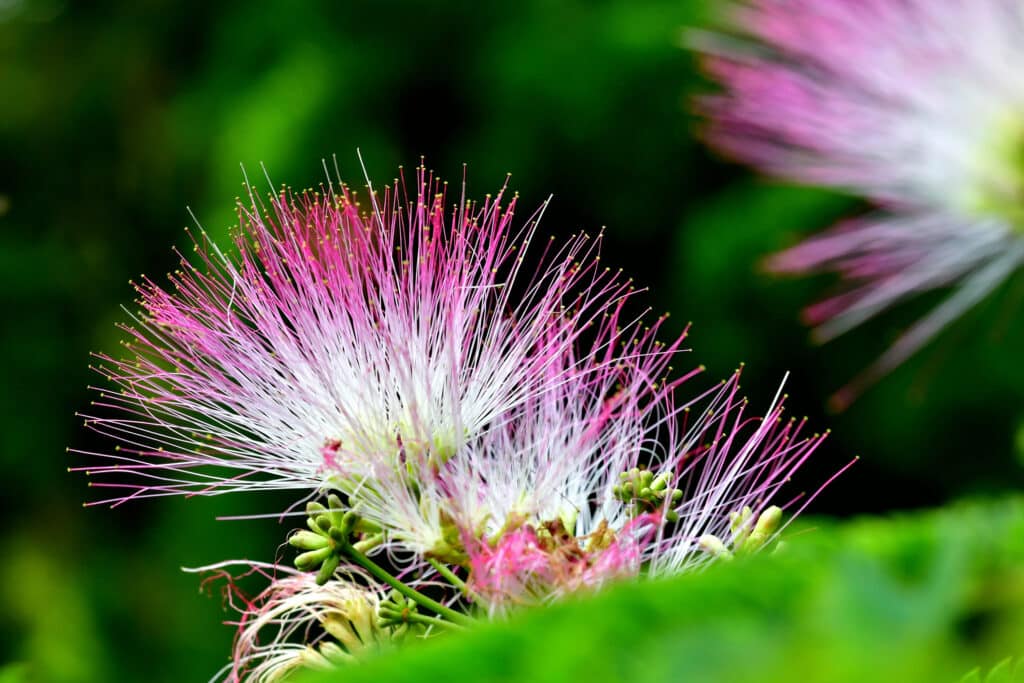Ever wondered about that graceful tree with fluffy pink flowers that adds a tropical touch to many Hawaiian landscapes? That’s the Mimosa Tree (Albizia julibrissin), also known as the Silk Tree. With its wide, umbrella-like canopy and delicate, fern-like leaves, this tree is a popular choice for adding beauty and shade to yards and gardens.
Mimosa Tree Details
The Mimosa Tree (Albizia julibrissin) is a fast-growing, deciduous tree that can reach heights of 20 to 40 feet with a canopy just as wide.
Its umbrella-like shape makes it a great choice for providing shade, especially in Hawaii’s warm and sunny climate.
One of its most striking features is its pink, silky flowers that bloom during the dry season, creating a soft and feathery display.
These flowers not only add beauty but also attract pollinators like bees, butterflies, and hummingbirds, making the tree beneficial for the local ecosystem.

Varieties and Cultivars
The Mimosa Tree comes in several varieties and cultivars, each offering unique characteristics that make them stand out in different landscapes. Some have striking foliage colors, while others boast enhanced flowering or reduced invasiveness, making them ideal choices for gardens in Hawaii.
Here are some of the most notable cultivars:
- Summer Chocolate – This variety is known for its deep burgundy leaves that turn even darker in the dry season. The pink, fluffy flowers provide a stunning contrast, making it a standout ornamental tree.
- Rosea – A popular choice for its extra vibrant pink blossoms, this cultivar adds an even more dramatic splash of color to any garden.
- E.H. Wilson – This variety features more cold-hardy traits, but it still thrives in warm climates like Hawaii. It has softer pink flowers and a more compact growth habit.
- Pendula – Unlike other varieties, this cultivar has a weeping growth form, giving it a graceful, cascading appearance. It’s often used for decorative landscaping.
- Ishii Weeping – Similar to Pendula, this variety also has a drooping canopy, making it a great option for those who prefer a unique, flowing shape.
Some cultivars have been selectively bred to be less invasive, producing fewer seed pods to reduce their spread. When choosing a Mimosa Tree for a Hawaiian garden, it’s important to consider not only visual appeal but also growth behavior to ensure it fits well with the surrounding environment.
Best Time to Plant
Year-Round Planting Feasibility
Since Hawaii has a tropical climate, Mimosa Trees can be planted at any time of the year. The tree’s ability to adapt to different conditions makes it a low-maintenance choice for homeowners looking to add shade and beauty to their gardens.
Even though the tree can survive in various conditions, planting during the right season can improve its growth rate and overall health. Young trees need consistent moisture to establish strong roots, which is why timing matters.
Hawaii’s weather is mostly warm and humid, which benefits the tree’s growth, but planting at the right time ensures it gets the best start. For quicker establishment, it’s best to plant when natural rainfall is more frequent.
Ideal Planting Seasons in Hawaii
- Wet Season (November to March) – This is the best time to plant a Mimosa Tree because the natural rainfall helps young trees establish their root systems. The extra moisture reduces the need for frequent manual watering.
- Dry Season (April to October) – While planting is still possible, extra care is needed. Young trees require regular watering to prevent drought stress, especially during the hotter months. Mulching around the base can help retain soil moisture.
- Avoid planting during extreme drought conditions – If the dry season is particularly harsh, it’s better to wait until more consistent rain returns to ensure the tree gets the moisture it needs.
For best results, plant the tree in a well-prepared location with good soil and proper drainage. A strong start will help the Mimosa Tree grow quickly and provide shade and beauty for years to come.
Growing Conditions
Ideal Soil Types and pH Levels
Mimosa Trees adapt well to different soil types but grow best in well-draining, loamy, or sandy soils.
They can tolerate poor or rocky soils, making them suitable for many areas in Hawaii.
The ideal soil pH range is between 6.0 and 7.0, but they can still grow in slightly acidic or alkaline conditions.
Heavy clay soils should be avoided since they retain too much moisture and can lead to root rot.
Light Requirements
Mimosa Trees thrive in full sun and need at least six to eight hours of direct sunlight each day.
While they can tolerate partial shade, too much shade can lead to leggy growth and fewer flowers.
Planting in an open area ensures maximum sunlight exposure and encourages a healthy, full canopy.
If growing near taller trees or buildings, it is important to ensure the Mimosa still gets enough direct sunlight throughout the day.
Sunlight exposure also helps prevent fungal diseases that can develop in consistently damp, shaded areas.
Temperature and Humidity Preferences
The Mimosa Tree grows well in Hawaii’s warm temperatures and high humidity, making it well-suited for tropical landscapes.
It thrives in temperatures ranging from 65°F to 85°F, which aligns perfectly with Hawaii’s climate.
While the tree can handle high humidity, proper airflow around the canopy helps prevent disease.
Though it prefers warmth, it cannot tolerate frost or cold snaps, making it unsuitable for high-elevation areas with cooler conditions.
The consistently warm weather promotes faster growth, making it an excellent choice for quick shade and ornamental value.
Drought Tolerance
Once established, the Mimosa Tree becomes highly drought-tolerant and requires little supplemental watering.
Young trees, however, need regular watering for the first six to twelve months to help their roots develop.
During Hawaii’s dry season, occasional deep watering helps keep the tree healthy.
A layer of mulch around the base helps retain soil moisture and reduces water loss.
Even though it can survive dry conditions, providing occasional watering will keep it looking lush and vibrant year-round.
With the right growing conditions, the Mimosa Tree can flourish in Hawaiian landscapes, adding beauty and shade with minimal effort.
How To Grow And Care For A Mimosa Tree In Hawaii
Planting Instructions
Planting a Mimosa Tree in Hawaii is a simple process, but taking the right steps will ensure healthy growth and long-term success.
Since the tree grows quickly and spreads widely, it is important to choose a proper location and follow the correct planting techniques.
Step-By-Step Guide
Following the right planting steps will help your Mimosa Tree establish itself quickly and grow into a strong, healthy tree.
- Select A Planting Site – That receives full sun and has well-draining soil.
- Dig A Hole – That is twice as wide as the tree’s root ball and about the same depth.
- Place The Tree In The Hole – Ensuring that the root ball sits level with the ground surface.
- Backfill The Hole With Soil – Gently pressing it down to remove air pockets while being careful not to compact it too much.
- Water The Tree Thoroughly After Planting – To help settle the soil and establish strong root growth.
Taking the time to plant your Mimosa Tree properly will ensure it gets off to a great start and adapts well to its new environment.
Tips For Successful Establishment
Once planted, your Mimosa Tree will need some extra care in the beginning to help it grow strong and healthy.
- Provide Enough Space – By planting the Mimosa Tree at least 20 to 30 feet away from buildings, fences, and other trees to allow for its wide canopy.
- Apply Mulch – Around the base of the tree to retain moisture, regulate soil temperature, and prevent weeds from competing with young roots.
- Water Regularly – For the first six to twelve months, especially during Hawaii’s dry season, to help the tree develop a deep and strong root system.
- Use Organic Compost Or Light Fertilizer – To give young trees an initial boost, although Mimosas generally thrive in low-nutrient soils.
With the right care and attention, your Mimosa Tree will establish itself quickly and provide years of beauty and shade in your Hawaiian landscape.
Care And Maintenance
Watering Needs
Keeping your Mimosa Tree properly watered is important, especially during the early stages of growth.
Young trees should be watered regularly for the first six to twelve months to help establish a deep root system.
Deep watering is best rather than frequent shallow watering, as it encourages stronger root growth.
Fertilization Recommendations
Although Mimosa Trees can thrive in poor soil conditions, a little fertilization can give them an extra boost.
A balanced fertilizer with equal parts nitrogen, phosphorus, and potassium is ideal for supporting overall growth.
Fertilizer should be applied in the early growth stages, especially when the tree is young, to encourage strong roots and healthy foliage.
For mature trees, fertilization should be limited since Mimosas do well in low-nutrient soils, and excessive fertilization may lead to weak branches.
Organic compost is a great alternative for those who prefer a natural option that improves soil health over time.
Pruning Guidelines
Regular pruning is essential to maintain the shape of your Mimosa Tree and prevent weak or overgrown branches.
Young trees should be pruned early to establish a strong branch structure and encourage balanced growth.
Removing weak or dead branches improves airflow and reduces the risk of disease or pest infestations.
Overgrown limbs should be trimmed to maintain the tree’s size and prevent it from interfering with nearby structures.

Common Problems And Solutions
While the Mimosa Tree is a hardy and fast-growing species, it is still vulnerable to certain pests, diseases, and environmental challenges.
Understanding these common problems and how to address them will help keep your tree healthy and thriving in Hawaii’s climate.
Common Pests
Mimosa Trees can attract a few common pests that may affect their overall health and appearance.
- Webworms – These pests create silky webs on branches and feed on the tree’s leaves, which can lead to defoliation.
- Scale Insects – Small, shell-like bumps that attach to branches and leaves while sucking nutrients from the tree, weakening its growth.
- Aphids – Tiny insects that cluster on new growth, causing leaf curling, discoloration, and a sticky residue known as honeydew.
Most pest infestations can be managed by spraying affected areas with a strong stream of water, applying neem oil, or introducing natural predators like ladybugs.
Keeping the tree well-pruned and ensuring good airflow will also help prevent severe infestations.
Common Diseases
Certain fungal diseases can impact the health of a Mimosa Tree, especially in humid conditions.
- Fusarium Wilt – A serious disease that causes yellowing leaves, branch dieback, and eventual tree decline, often starting with one affected limb.
- Root Rot – A fungal condition caused by poor drainage, leading to soft, decaying roots and overall tree weakness.
- Powdery Mildew – A white, powdery substance that appears on leaves, interfering with photosynthesis and slowing tree growth.
Preventing fungal diseases involves proper planting in well-draining soil, avoiding overwatering, and ensuring good airflow around the tree.
If disease symptoms appear, pruning infected branches and applying organic fungicides can help control the spread.
Preventative Measures And Treatments
Taking proactive steps will help protect your Mimosa Tree from pests and diseases before they become a serious problem.
Regularly inspecting the tree for early signs of infestation or disease will allow for quicker treatment and better results.
Avoiding excessive watering and planting in well-draining soil will reduce the risk of root rot and fungal infections.
Uses And Landscaping Tips
Landscaping Uses
Mimosa Trees are commonly used in landscaping for their unique appearance and ability to grow quickly.
They work well as shade trees, thanks to their umbrella-like canopy that provides relief from the sun.
Many homeowners plant them as ornamental trees to enhance garden aesthetics with their feathery foliage and vibrant flowers.
They are often used as focal points in yards, parks, and open spaces, creating a tropical feel with minimal maintenance.
Because of their drought tolerance, they are also suitable for xeriscaping, where low-water landscaping is preferred.
Companion Planting Ideas
Pairing the Mimosa Tree with the right plants can enhance its beauty while maintaining a balanced landscape.
Ground covers like liriope and ferns work well beneath the tree, filling in shaded areas without competing for nutrients.
Flowering shrubs such as hibiscus and plumeria complement the Mimosa’s pink blooms, adding more color and vibrancy to the garden.
Ornamental grasses like pampas grass or fountain grass create a natural, layered look while thriving in the same warm, dry conditions.
Tropical plants like bird of paradise and heliconias add a lush, exotic touch, blending well with the Mimosa Tree’s soft foliage.
Propagation Methods
Growing From Seeds
Propagating Mimosa Trees from seeds is the most common and straightforward method.
Fresh seeds should be collected from mature seed pods and soaked in warm water for 24 hours to soften the outer shell and improve germination.
After soaking, the seeds can be planted directly into well-draining soil, either in pots or directly in the ground.
Keeping the soil moist but not soggy will encourage sprouting, which usually occurs within one to two weeks in warm temperatures.
Once seedlings reach a height of six to twelve inches, they can be transplanted to their permanent location in the landscape.
Propagating From Cuttings
Using stem cuttings is another effective way to grow new Mimosa Trees while maintaining the exact characteristics of the parent plant.
Healthy branches should be cut during the dry season, ensuring each cutting is at least six inches long with several leaf nodes.
Cuttings should be dipped in rooting hormone to increase the chances of successful root development.
They should then be planted in a moist, sandy soil mix and kept in a warm, shaded area until roots begin to form.
Once strong roots develop, usually within a few months, the young trees can be moved to a sunnier location or planted directly into the ground.
Environmental Impact And Benefits
Ecological Benefits
The Mimosa Tree provides valuable shade, making it a great addition to gardens, parks, and outdoor spaces in Hawaii.
Its pink, fluffy flowers attract pollinators such as bees, butterflies, and hummingbirds, helping to support local ecosystems.
As a nitrogen-fixing tree, it naturally enriches the soil by improving nitrogen levels, which benefits surrounding plants.
Its deep root system helps prevent soil erosion, especially in areas with loose or sandy soil.
Because it is drought-tolerant, it can thrive in dry conditions with minimal water, making it a sustainable choice for landscaping.
Potential Drawbacks
Despite its beauty and benefits, the Mimosa Tree has some downsides that should be considered before planting.
It can be invasive in certain areas, as its seeds spread easily and can quickly establish new trees.
The tree produces long seed pods, which can create litter in yards, driveways, and sidewalks if not maintained properly.
Its branches can be weak and prone to breaking during high winds or storms, requiring regular pruning to prevent damage.
Conclusion
The Mimosa Tree is a beautiful and fast-growing tree that thrives in Hawaii’s tropical climate.
With its delicate pink flowers, wide canopy, and ability to grow in poor soils, it is an excellent choice for providing shade and enhancing landscapes.
By understanding the best planting techniques, proper care, and potential challenges, homeowners can successfully grow and maintain this tree with ease.
Although it requires some maintenance to prevent excessive spreading and weak branches, the Mimosa Tree offers many ecological and aesthetic benefits.
For those looking to add a unique and low-maintenance tree to their Hawaiian garden, the Mimosa Tree is a fantastic option.

